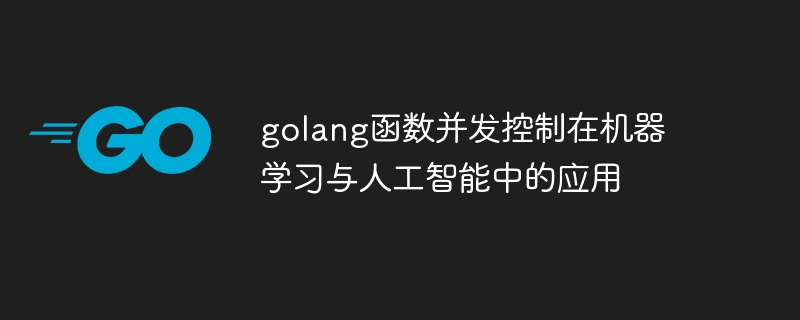golang函數並發控制在機器學習與人工智慧的應用
- WBOYWBOYWBOYWBOYWBOYWBOYWBOYWBOYWBOYWBOYWBOYWBOYWB原創
- 2024-04-24 14:12:011394瀏覽
並發控制透過 goroutine 實現,允許 Go 程式碼並發執行任務。在機器學習中,並發可用於加速資料處理,透過並行執行訓練批次等操作。在人工智慧領域,並發至關重要,尤其是在需要即時處理大量數據的應用中,例如影像辨識和自動駕駛。實戰案例展示了使用 Go 的 TensorFlow 庫實現圖像分類,利用並發性加載批次圖像資料並執行模型推理。

Go 語言函數並發控制在機器學習與人工智慧中的應用
#是開發高效能和可擴展代碼的關鍵方面。在機器學習和人工智慧 (ML/AI) 應用中,並發尤其重要,因為這些應用通常需要處理大量的數據和計算。
何為並發控制?
並發控制允許程式同時執行多個任務。在 Go 語言中,這可以透過 goroutine(輕量級線程)來實現。當在一個 goroutine 中運行函數時,該函數將與應用程式的其他部分同時運行。
如何使用Goroutine 實現並發
並發使用goroutine 可透過以下方式實現:
func myFunction() {
// 代码
}
// 创建一个 goroutine 来并发执行 myFunction
go myFunction()機器學習中的並發
機器學習演算法通常需要重複執行計算密集型操作。透過使用並發,可以將這些操作劃分到不同的 goroutine 中,從而顯著提高效能。
例如,在訓練神經網路時,可以透過同時執行多個訓練批次來加快訓練過程:
// 启动多个 goroutine 并行训练
for i := 0; i < numGoroutines; i++ {
go trainBatch(i)
}
// trainBatch 函数处理每个批次的训练
func trainBatch(batchNumber int) {
...
}人工智慧中的並發
#在人工智慧領域,並發同樣至關重要,尤其是在即時應用中。例如,在自動駕駛汽車中,需要同時處理來自不同感測器的數據和做出即時決策。
以下是一個使用並行處理圖像辨識任務的範例:
// 并发处理图像识别
results := make(chan string, numImages)
for i := 0; i < numImages; i++ {
// 创建一个 goroutine 来处理每个图像
go func(imageIndex int) {
label := recognizeImage(imageIndex)
results <- label
}(i)
}
// 从频道读取识别的标签
for i := 0; i < numImages; i++ {
...
}實戰案例- 影像分類
讓我們建立一個簡單的影像分類模型,使用Go 語言的TensorFlow 庫。我們將使用訓練好的 ImageNet 模型來辨識影像。
package main
import (
"context"
"fmt"
tf "github.com/tensorflow/tensorflow/go"
"github.com/tensorflow/tensorflow/go/core/resourcemanager"
"github.com/tensorflow/tensorflow/go/op"
"github.com/tensorflow/tensorflow/go/types"
)
func main() {
// 创建一个新的 TensorFlow 会话
sess, err := tf.NewSession(context.Background(), "local", nil)
if err != nil {
fmt.Println(err)
return
}
defer sess.Close()
// 准备输入图片
var imageData []byte
...
// 使用并发加载多批图像
numImages := 10 // 修改为实际图像数量
batchSize := 4
var blobs [][]byte
for i := 0; i < numImages; i += batchSize {
batch := imageData[i : i+batchSize]
blobs = append(blobs, batch)
}
// 创建 TensorFlow 图表
graph, err := op.NewGraph()
if err != nil {
fmt.Println(err)
return
}
placeholder := graph.Placeholder(types.Bool, op.WithName("input_tensors"))
inTypes := make([]*types.T, len(blobs))
for i, _ := range inTypes {
inTypes[i] = types.Bytes
}
enqueueOp := op.QueueEnqueue(placeholder).Inputs(inTypes)
ready, components, queueClose := op.QueueEnqueueMany(placeholder).Args(placeholder, placeholder).Attrs(map[string]interface{}{
"component_types": types.BytesList,
}).Output(0).Output(1).Output(2)
inTensor := op.BuildQueueDequeue(components, op.BuildQueueLen(components[2]), op.BuildQueueSize(components[2]), op.BuildQueueClosed(components[2]))
modelPath := "path/to/ImageNet_model" // 修改为实际模型路径
output, err := resourcemanager.LoadModel(modelPath, inTensor, graph)
if err != nil {
fmt.Println(err)
return
}
// 运行模型
for i, blob := range blobs {
// 并发执行
go func(i int, blob []byte) {
sess.Run(op.NewOperation(sess.Graph()).AddInput(placeholder, blob).MustSetAttr("component_type", types.String("string")).Output(enqueueOp),)
}(i, blob)
}
for {
readyArr, err := sess.Run(ready)
if err != nil {
fmt.Println(err)
break
}
// 处理结果
if readyArr.(bool) == true {
_, err = sess.Run(op.NewOperation(graph).AddInput(inTensor, 0).Output(output))
if err != nil {
fmt.Println(err)
}
} else {
break
}
}
// 处理剩余的图像
sess.Run(op.NewOperation(sess.Graph()).AddInput(placeholder, []byte(nil)).MustSetAttr("component_type", types.String("string")).Output(queueClose))
}注意:為了簡明起見,程式碼省略了錯誤處理和 TensorFlow 會話管理的完整性。務必在生產代碼中包含適當的錯誤處理。
以上是golang函數並發控制在機器學習與人工智慧的應用的詳細內容。更多資訊請關注PHP中文網其他相關文章!

